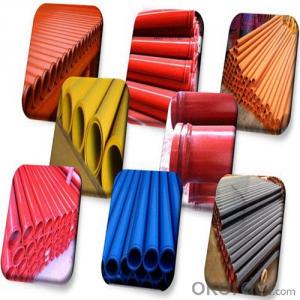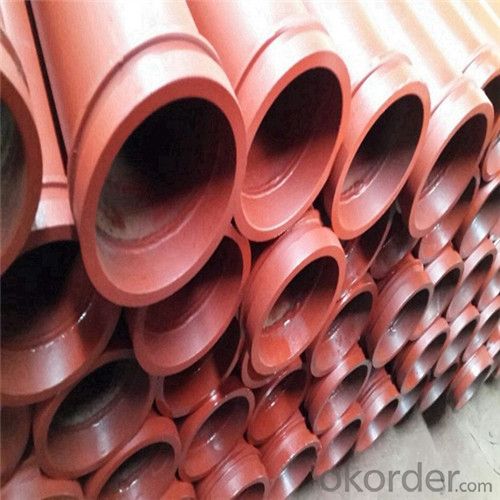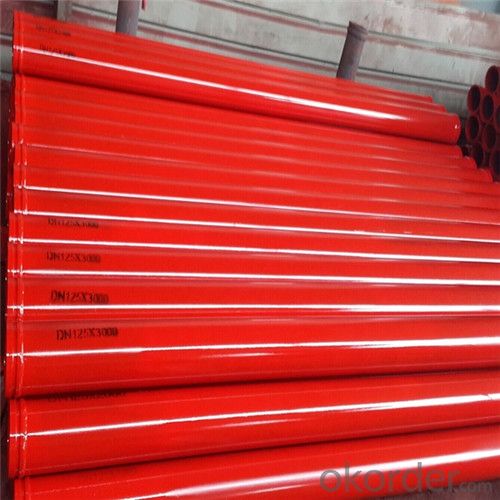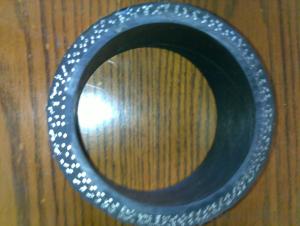3M Seamless Delivery Pipe for Concrete Pump Thickness 5.0mm
- Loading Port:
- Tianjin
- Payment Terms:
- TT or LC
- Min Order Qty:
- 50 pc
- Supply Capability:
- 5000 pc/month
OKorder Service Pledge
OKorder Financial Service
You Might Also Like
3M Seamless Delivery Pipe for Concrete Pump Thickness 5.0mm
1. Structure of 3M Seamless Delivery Pipe for Concrete Pump Thickness 5.0mm:
St52 Weld Pipe: Main use for Trailer-mounted pump, thickness has 4.0mm, 4.5mm, 5mm. Compare with for Truck-mounted pump. Weld pipe has cheaper price, so it is popular in Saudi, Pakistan, India, etc. Unit Price is about 30USD-33USD.
St52 Seamless Pipe: Now More People like use this kind for Truck Pump and Trailer Pump because of the quality is better and it is seamless kind, so this kind pipe is most popular in Middle East Price About 34USD-37USD.
Two Wall Pipe: This pipe thickness (2mm+2.5mm), Using Life about 50,000m³-60,000m³
2. Main Features of 3M Seamless Delivery Pipe for Concrete Pump Thickness 5.0mm:
• High Wear-resistant, long service life, lower cost
• In case of quality problem the company provide free replacement.
• Provide technical support for free.
• Provide consumers with regular visits
• Ensure the supply of ancillary parts
• Our company passed the ISO9000 certification, the product through 3C certification in full compliance with national standards
3. 3M Seamless Delivery Pipe for Concrete Pump Thickness 5.0mm Images
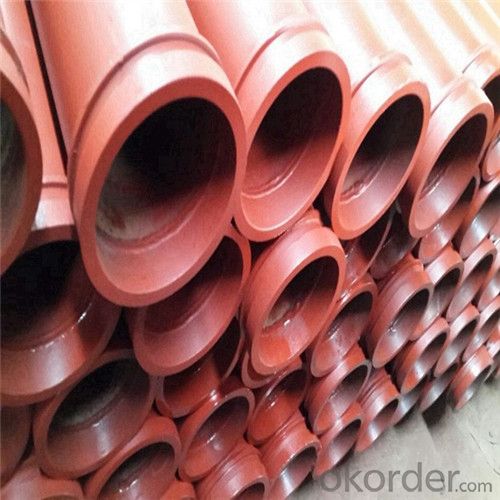


4. 3M Seamless Delivery Pipe for Concrete Pump Thickness 5.0mm Specification


Production Process

5. FAQ
We have organized several common questions for our clients, may help you sincerely:
①Is your products exported a lot?
We have exported to many, many countries. Every year we ship more than 30 containers of these spare parts. Our main market is in Middle-east, Asia & Africa.
②How to guarantee the quality of the products?
We have established the international advanced quality management system,every link from raw material to final product we have strict quality test;We resolutely put an end to unqualified products flowing into the market. At the same time, we will provide necessary follow-up service assurance.
③How long can we receive the product after purchase?
In the purchase of product within three working days, we will arrange the factory delivery as soon as possible. The specific time of receiving is related to the state and position of customers. Commonly 15 working days can be served.
- Q: Are there any specific recommendations for the inspection and testing of concrete pump spare parts?
- Yes, there are specific recommendations for the inspection and testing of concrete pump spare parts. It is important to regularly inspect and test the spare parts to ensure their functionality, durability, and safety. Some recommendations include conducting visual inspections for any signs of wear, corrosion, or damage, performing pressure tests to check for leaks or weak spots, and checking the dimensions and specifications to ensure proper fit and compatibility. Additionally, following the manufacturer's guidelines and consulting with experts in the field can provide further guidance on specific inspection and testing procedures for concrete pump spare parts.
- Q: Are there any specific guidelines for the installation of hopper components or agitators in concrete pump spare parts?
- Yes, there are specific guidelines for the installation of hopper components or agitators in concrete pump spare parts. These guidelines typically include instructions on proper alignment, securing of bolts, lubrication, and ensuring all components are properly connected. It is important to follow these guidelines to ensure safe and efficient operation of the concrete pump.
- Q: How often should hopper grate springs be inspected or replaced in a concrete pump?
- To ensure optimal performance and prevent potential issues, it is essential to regularly inspect the hopper grate springs in a concrete pump. The frequency of inspection or replacement depends on factors such as pump usage, operating conditions, and manufacturer recommendations. However, a general rule is to inspect the springs at least every six months or after every 500 hours of operation, whichever comes first. During the inspection, thoroughly examine the springs for any signs of wear, damage, or deformation. Check for cracks, excessive rust, or loss of tension. If any of these issues are found, immediate replacement is necessary to maintain proper functioning of the hopper grate system. Regular inspection and timely replacement of hopper grate springs are vital to prevent clogging or blockage in the hopper, which can lead to pump malfunctions or downtime. It is advisable to consult the concrete pump manufacturer's guidelines or seek assistance from a professional technician to determine specific inspection and replacement intervals based on the pump's make and model.
- Q: What is the purpose of a concrete pump boom?
- The purpose of a concrete pump boom is to provide an efficient and effective method for transferring concrete from the mixer truck to the desired location on a construction site. The boom is typically mounted on a truck or trailer and consists of a series of connected sections that can be extended and maneuvered to reach areas that are otherwise difficult to access. Concrete pump booms offer several advantages over traditional methods of concrete placement. Firstly, they significantly reduce the labor required for concrete placement, as the boom can reach over obstacles such as buildings or other structures, eliminating the need for manual pouring or the use of cranes. This saves time and money on a construction project. Additionally, concrete pump booms allow for precise and accurate placement of concrete. The boom can be controlled remotely, allowing the operator to position the nozzle exactly where the concrete is needed. This ensures a more uniform and even distribution of concrete, resulting in a higher quality finished product. Furthermore, concrete pump booms increase safety on construction sites. By eliminating the need for workers to physically transport and pour concrete, the risk of injuries and accidents is significantly reduced. The boom also allows for the placement of concrete in hard-to-reach areas, minimizing the need for workers to climb or work at heights, further enhancing safety. In conclusion, the purpose of a concrete pump boom is to provide a more efficient, precise, and safe method for transferring and placing concrete on construction sites. Its ability to reach over obstacles, accurately control placement, and reduce labor requirements make it an invaluable tool in the construction industry.
- Q: How does a hopper agitator blade ensure smooth concrete flow?
- A hopper agitator blade ensures smooth concrete flow by constantly mixing and agitating the concrete inside the hopper. This prevents the concrete from settling or forming clumps, ensuring a consistent and even flow of the material. The agitation action of the blade also helps to break up any air pockets that may be present in the concrete, resulting in a more uniform and high-quality mixture.
- Q: How do I properly adjust and control flow rates in concrete pump spare parts?
- To properly adjust and control flow rates in concrete pump spare parts, you should start by examining the pump's manual and understanding its specific settings and controls. It's important to ensure that all valves and levers are in the correct position and functioning properly. Additionally, you can adjust the flow rate by manipulating the stroke length and speed of the pump. Experimenting with these settings while monitoring the flow rate will help you achieve the desired results. Regular maintenance and cleaning of the pump parts are also crucial to ensure smooth flow control.
- Q: How do I properly maintain and replace rubber pistons in concrete pump spare parts?
- Proper maintenance and replacement of rubber pistons in concrete pump spare parts involves a few key steps. Firstly, make sure to regularly inspect the pistons for any signs of wear, such as cracks or tears. It is recommended to replace them if they are significantly worn or damaged. To replace the rubber pistons, start by removing the old piston carefully, ensuring not to damage the cylinder or any other components. Clean the cylinder thoroughly, removing any debris or residue. Apply a lubricant or concrete pump primer to the cylinder walls to aid in the installation of the new piston. Next, carefully install the new rubber piston, ensuring it is properly aligned with the cylinder. Gently push it into place, avoiding any unnecessary force that could cause damage. It is important to refer to the manufacturer's instructions or guidelines for specific installation techniques. After replacing the rubber piston, run a few tests to ensure its proper functioning. Check for proper sealing and smooth operation by conducting a dry run or pumping a small amount of concrete. Monitor the piston's performance closely, and if any issues arise, consult a professional or the manufacturer for further guidance. Regular maintenance, such as cleaning the cylinder and lubricating the pistons, can help extend their lifespan. Additionally, following proper operating procedures, such as avoiding excessive pressure or abrasive materials, can also contribute to the longevity of rubber pistons.
- Q: Which height of concrete pump is the most practical?
- The clay pump truck is modified on a truck chassis. It is mounted on the chassis with a power and motion device, a pump and a mixing device, a cloth arrangement, and other auxiliary devices
- Q: What is the purpose of a concrete pump cylinder?
- The purpose of a concrete pump cylinder is to provide the necessary pressure and force to transport and deliver concrete from the pump to the desired location. The cylinder is an essential component of a concrete pump, as it allows for the efficient movement of concrete through the pump system. The cylinder works by using hydraulic pressure to push the concrete through the pipeline, ensuring a continuous and smooth flow of concrete. It plays a crucial role in construction projects, enabling concrete to be precisely and efficiently placed in various locations, such as buildings, bridges, or other structures. By providing the necessary power and pressure, the concrete pump cylinder ensures that concrete can be transported over long distances, vertically or horizontally, with minimal effort and labor. Overall, its purpose is to facilitate the efficient and precise delivery of concrete, saving time and effort in construction projects.
- Q: Can concrete pump spare parts be repaired on-site, or should they be sent to a specialized repair facility?
- In certain cases, it is possible to repair concrete pump spare parts on-site, while in others, it may be necessary to send them to a specialized repair facility. The choice between on-site repair or specialized repair depends on factors such as the nature and complexity of the repair required, the availability of skilled technicians and equipment, and the time constraints of the project. For minor repairs or replacements of simple components, it is often feasible to carry out the work on-site. This can include tasks like replacing hoses, seals, or filters, which can be completed quickly and easily with basic tools and equipment. Operators or maintenance personnel can often handle these types of repairs themselves, without the need for specialized technicians. However, for more complicated repairs or replacements, it is advisable to send the spare parts to a specialized repair facility. This is especially true for critical components such as hydraulic cylinders, valves, or control systems, which require specialized knowledge and expertise to repair effectively. Specialized repair facilities employ trained technicians who specialize in specific equipment and have the necessary tools and resources to diagnose and resolve complex issues. Furthermore, specialized repair facilities often have access to a broader range of spare parts and can obtain genuine parts from the original manufacturer. This ensures that the repaired spare parts are of high quality and compatible with the specific make and model of the concrete pump. Additionally, these facilities may offer warranties on their repairs, providing reassurance to equipment owners. Ultimately, the decision to repair on-site or send for specialized repair depends on the unique circumstances and available resources. It is crucial to evaluate the complexity of the repair, the availability of skilled technicians, and the potential impact on the project timeline before determining the most appropriate course of action.
Send your message to us
3M Seamless Delivery Pipe for Concrete Pump Thickness 5.0mm
- Loading Port:
- Tianjin
- Payment Terms:
- TT or LC
- Min Order Qty:
- 50 pc
- Supply Capability:
- 5000 pc/month
OKorder Service Pledge
OKorder Financial Service
Similar products
Hot products
Hot Searches
Related keywords


